From internal pipelines, drains are transported by external ...

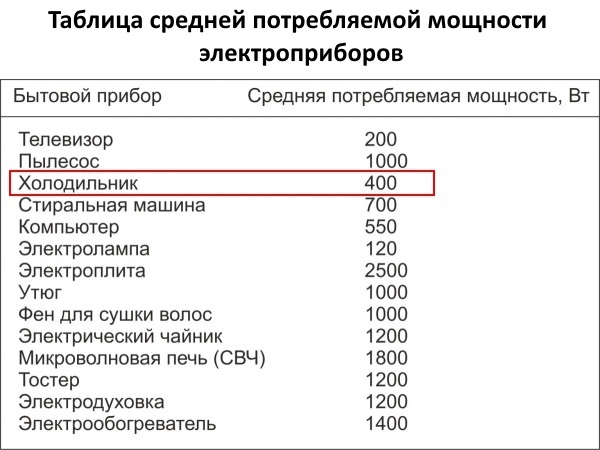
Choosing household appliances for your home will never be superfluous to pay attention to the amount of kilowatts consumed. Refrigerators are no exception, since they have many components that consume energy. Many of them "eat" kW in a round-the-clock mode for many years while the refrigerator is operational. True, not all consumers, especially without knowledge of some technical fundamentals, understand this and attach importance to this. Considering the capacity of the refrigerator measured in kW when it is selected, you can save on the payment of electricity bills in the future. Knowledge of such a characteristic as power consumption and the ability to calculate its average indicator will definitely lead to savings in the family budget.
The indicator of power consumption is the total amount of electricity spent on the operation of all components of the refrigerator. Electricity is spent on the operation of the compressor, fan, lighting and other electrical elements. In order to determine the average value of energy consumption, you need to know how many kilowatts the refrigerator consumes per day.
To find out the indicator of the power consumption of the refrigerator, you need to refer to the technical documentation that comes with the device. You can additionally find this information on the sticker, which is located either on the back of the case, or inside the refrigerator / freezer. The manufacturer usually indicates the average and maximum values \u200b\u200bof the rated power. The first ranges from 0.1 to 0.2 kW per hour, and the second (considering the compressor) is in the region of 0.3 kW / h. These indicators are indicated on the basis that the maintained temperature inside the refrigerator corresponds to + 5 ° C with an ambient (external) of + 25 ° C.
The term maximum power consumption was introduced because the compressor is not always involved. He performs his work on pumping refrigerant (freon) along the circuit of the system as necessary. When the temperature exceeds the set value, the sensor is triggered, sending a signal to turn on the compressor. In refrigerators, depending on the model, the number of sensors can be different. This allows you to maintain its independent temperature in different parts (zones). Therefore, the amount of electricity consumed may differ from the nominal indicator stated in the documents.
 Choosing your refrigerator suitable for power from a variety of models, special marking can additionally help to save electricity. It indicates the energy class of the refrigerator and is indicated in Latin letters. There are seven letters in all from A to G. Class A has an additional gradation, which is indicated by the “+” sign. So, there are such classes: A +, A ++ and A +++, the class A +++ is considered the best in terms of energy consumption. The values \u200b\u200bthat correspond to each letter determine the average power of the refrigerator in kW.
Choosing your refrigerator suitable for power from a variety of models, special marking can additionally help to save electricity. It indicates the energy class of the refrigerator and is indicated in Latin letters. There are seven letters in all from A to G. Class A has an additional gradation, which is indicated by the “+” sign. So, there are such classes: A +, A ++ and A +++, the class A +++ is considered the best in terms of energy consumption. The values \u200b\u200bthat correspond to each letter determine the average power of the refrigerator in kW.
It is very convenient to navigate when choosing, since not only one compressor consumes energy. Different models of refrigerators under different operating conditions can consume a different amount of electricity. The total energy consumption is influenced by such moments as:
The power consumption is calculated per year of operation of the device for a power supply network with a voltage of 220 V and a frequency of 50 Hz. The calculation is made per hundred liters of usable volume per day. This approach makes it possible to compare refrigerators of different sizes. At the same time, the total capacity of the refrigerator in kW will depend on the internal volume of the chambers and the number of products placed in it. In addition, external conditions make a certain contribution to energy consumption. They can change during operation and season.
 The technical documentation for the refrigerator displays the energy consumption for the year. Usually this figure is in the range of 230-450 kW / h. Performing a simple calculation, dividing this value by 12 months, you get the power consumption per month. So it should be in the range of 20-40 kW / h. It is worth noting that these values \u200b\u200bare valid only for operation in ideal conditions. In practice, it is unlikely to achieve such readings of electricity consumption.
The technical documentation for the refrigerator displays the energy consumption for the year. Usually this figure is in the range of 230-450 kW / h. Performing a simple calculation, dividing this value by 12 months, you get the power consumption per month. So it should be in the range of 20-40 kW / h. It is worth noting that these values \u200b\u200bare valid only for operation in ideal conditions. In practice, it is unlikely to achieve such readings of electricity consumption.
To find out how much your refrigerator consumes, information from technical specifications devices in which the amount of kW consumed per day and per year will be indicated. The indicated readings must be averaged taking into account the error. The error depends on: the total load of the refrigerator, the number of cycles of opening / closing the door and their duration, the temperature in the room (the norm is 24-27 ° C).
The power consumption of the refrigerator is inextricably linked with the power of the freezer. Freezing refers to the volume of products that a refrigerator can freeze to a temperature of -18 ° C in one day. This implies that initially the products will be at room temperature. This indicator is also reflected in the technical documentation for the device. In the documents it is marked in the form of "X (***)" and is measured in the amount of kilograms per day (kg / s). Different manufacturers usually produce models of refrigerators with a freezing capacity from 17 to 30 kg / s.
A number of recommendations will help reduce energy consumption. They are quite simple and observing them can reduce electricity consumption.
The information provided will help determine the power of the refrigerator in kW and choose the most economical model. The correct and sensible choice of household appliances will always turn into a benefit for the family budget during its operation.
Is it necessary to pay attention to the power of the refrigerator when buying it? Do you know that his lulling rumbling takes 30% (at least!) Of all the electricity consumed by your kitchen assistants? And no wonder, because this monster for the destruction of kilowatts is connected to the electricity network around the clock. Here is the result!
But how do you know how much power your particular refrigerator is and how much it costs (or will cost) its presence in your kitchen?
Examine the information on the sticker, which is usually located on the wall of the refrigerator or inside the chamber, and you will find out its power, as well as other characteristics of the device. The power consumption of the refrigerator is nothing more than an indicator of the highest electricity consumption for the normal operation of the device. It is measured in watts (W) and depends on the volume of the refrigerator compartment, compressor, the presence of additional functions, the quality of the insulation of the sealant. And also from the correct operation.

So, the greatest indicator of energy consumption is during compressor operation. It turns on periodically when it receives a signal from sensors that record the temperature change inside the refrigerator. It becomes as warm as possible in the chamber - this is a signal for the compressor to start pumping freon through the tubes, which cools the walls inside the unit. It is at this moment that the refrigerator consumes the maximum amount of electricity.
What numbers will you see on the information sticker? The average power of the refrigerator varies between 100 and 200 W / hour (in a state of calm), the maximum is 300 W / hour (during compressor operation), that is, the average figure is about 250 watts. Do not forget that the refrigerator, plugged into the outlet around the clock, works periodically. About a day, the device consumes a minimum of 1.5 kW, a maximum of 3.5 kW. This is provided that the temperature in the refrigerator does not fall below + 5 ° C, and in the room stay at + 25 ° C, but no more.
Energy consumption can change significantly if the refrigerator has two compressors. Indeed, during their work, the amount of energy used increases. Consider this too!
Energy consumption varies significantly from some nuances that are not related to the manufacturer:

The power of the refrigerator also determines its energy efficiency, power freezing, the presence of additional functions.
Take for example the most famous companies and see what they can boast of. Please note that the larger the numbers, the greater the energy consumption:
Additional features increase power consumption. It can be self-freezing, accelerated freezing, super-cooling mode, ice maker. They make our life easier, but you have to pay for amenities. You are ready? Carefully choose electrical appliances and operate them correctly!
Why is it important to know what the power consumption of the refrigerator in your home is?
The refrigerator is one of the few household appliances that operate continuously and consume electricity around the clock, 24/7.
Therefore, when choosing a refrigerator, it is extremely important to evaluate not only its volume, functionality, ease of use and maintenance, design and how it fits into the interior of the kitchen, but also how expensive it will cost you the electricity that it consumes.
It is not easy for a person without a technical education to compare the fact of acquiring an overly powerful refrigerator and the unexpected jump in the numbers in electricity bills, because all the refrigerators, at first glance, are approximately the same, perform the same functions and operate in identical mode.
 But the difference in power consumption between two different devices can be quite impressive.
But the difference in power consumption between two different devices can be quite impressive.
What makes up the energy consumption of the refrigerator? In addition to the direct operation of the compressor, aimed at cooling the air inside the device, in the complex system of the refrigeration unit there are a lot of minor components that also consume electricity for their work: these are all kinds of bulbs, indicators, fans, elements for heating the internal parts of the device.
All these little things also wind up a certain amount of watts on the meter, or even kilowatts daily.
The total amount of energy used by all components of the appliance is added up to a value called its power consumption.
The manufacturer indicates the final indicator of power consumption in kilowatts (kW), firstly, on the information label pasted most often on the outer wall of the device, and secondly, it must be prescribed in the operating instructions that are supplied with any electrical appliance.
 On modern models, the energy class is indicated - the letter code from A to G, to which one or more pluses are added (for class A refrigerators). Theoretically, the more pluses, the more economical a refrigerator should use an energy resource, but in practice a small simple class A refrigerator comes out more economical than a huge one, stuffed with electronics, a No Frost system and an A +++ class ice machine.
On modern models, the energy class is indicated - the letter code from A to G, to which one or more pluses are added (for class A refrigerators). Theoretically, the more pluses, the more economical a refrigerator should use an energy resource, but in practice a small simple class A refrigerator comes out more economical than a huge one, stuffed with electronics, a No Frost system and an A +++ class ice machine.
The instruction manual indicates 2 indicators of power consumption - average and maximum. The average rated power is the number of kilowatts consumed by the refrigerator during the day.
This value is usually 100-200 W / h, provided that -5 ° C is maintained at an ambient temperature of +25 ° C. The maximum power is slightly higher, up to 300 W / h, and this is the energy consumption with the compressor running, since it is the most energy-consuming element in the design of the refrigerator.
However, the compressor, which pumps freon along the cooling circuit, does not work continuously, but is turned on only by the signal of special sensors in case the temperature inside the refrigerating chamber rises above the set limit. Therefore, the average rated power of the refrigerator is much lower than the maximum.

In addition to the power and the number of compressors, many more factors influence the amount of electricity consumed by the refrigerator:
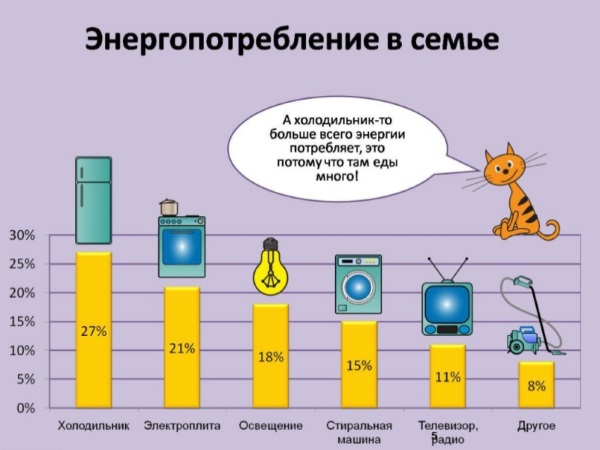 What if the purchase of a new refrigerator is not planned yet, but I would like to reduce the energy consumption of the old one? Unfortunately, it is possible to significantly reduce electricity consumption by the refrigerator only by completely disconnecting it from the network.
What if the purchase of a new refrigerator is not planned yet, but I would like to reduce the energy consumption of the old one? Unfortunately, it is possible to significantly reduce electricity consumption by the refrigerator only by completely disconnecting it from the network.
Without this, any refrigerator will still account for at least 30% of the energy consumed by all your household electrical appliances.
However, there are some simple rules that will allow you to spend energy less wastefully:
When it comes time to decide on the purchase of a new model, think about the feasibility, so as not to buy features and capacities you do not need, which will ultimately result in increased costs for paying electricity bills.

Each owner sooner or later thinks about how much electricity this or that device consumes. This indicator is especially important with the current increase in electricity prices or if you decide to switch to an autonomous energy supply.
The main and necessary consumers in the house have always been and remain lighting bulbs and a refrigerator. They are necessary not only for comfort, but rather for ordinary existence. That is why the question “How much does the refrigerator consume?” Is asked first of all when calculating the energy consumption.
Of course, it is impossible to level all units under one comb. Power depends on many factors - productivity, functionality, and so on.
In general, the power consumption of a refrigerator is the total amount of energy it consumes per month / day / year. We are used to considering a refrigerator as one consumer. But this one consists of at least three components - a compressor (or several), fans and heaters. It is their energy consumption in total that is taken into account.
There are several factors that affect the power of a device, namely:
All of these factors can double declared consumption.
The instructions indicate the average, which is usually about 250 watts.
To a greater extent, the total energy consumption depends on how much power the compressor of the refrigerator.
Consumption during freezing directly depends on the number of products that the refrigerator must cool (freeze) to -18 degrees per day. Here it is taken into account that the mortgaged products are at room temperature. It is measured in kilograms per day (kg / day). You can find out what power your freezer has by the designation on the sticker (outside or inside the unit) and in the instructions marked “X” and ***.
When choosing a refrigerator, you must pay attention to this indicator. Different manufacturers make household models with different capacities. For example, Indesit - up to 30 kg / day, Atlant - up to 21 kg / day, Samsung - up to 15 kg / day.
This indicator is measured in watts (W) and kilowatts (kW).
To calculate the real average consumption, you need to know the power of the refrigerator in kW, consumption per day.
You can do this with a multimeter (a device that measures the voltage in a circuit). To do this, you must at least understand where this chain is located. Measure in this way while the compressor is running. The resulting indicator must be multiplied by 220 (voltage) and 3.
Another method for those who do not understand all these circuits and voltages. In the manual for the device and on it itself (sticker), the manufacturer indicates the maximum and rated (average) power of the unit.
The first indicator is measured at the time of compressor operation. Since it does not work continuously, but only after the temperature sensor is triggered, this is the maximum power. Usually it is 0.3 kW / h. The average power is 0.1 - 0.2 kW / h.
Surely you know that it is better to take models marked A, A + and so on. Such refrigerators consume electricity most economically.
Well, if the model you like is marked B, do not you take it? What is the difference between them and how critical is it?
So, let's start from the beginning. There are currently 10 classes of energy saving. They are denoted by Latin letters from A to G and A +, A ++, A +++. The latter is the most economical.
For example, the capacity of a LG Class A domestic refrigerator will be around 350-360 kW per year.
The differences between the classes are really significant - each subsequent one spends 10% more energy than the previous one.

| Model | Electrolux | Atlant | LG | Biryusa | Samsung |
| Compressors | 1 | 1 | 1 | 2 |
In the housing of modern man there are many useful devices, without which it is impossible to do. Each device consumes electricity. Not everyone understands the amount of energy that is needed to operate household appliances. But how many watts a refrigerator consumes, everyone needs to know. This indicator largely depends on the operating conditions and the type of device. How to reduce its power consumption will be said in this article.
If you do not delve into physical concepts, then electricity is called a product that the owners acquire for the operation of devices. Consumption is calculated in kilowatt hours. In the data sheet of devices the amount of energy consumed by them is indicated, not taking into account the operating mode. But in order to calculate exactly how much electricity is needed for their work, you need to know this expense.
How many watts a refrigerator consumes cannot be calculated using data from the data sheet. This information is required to arrange wiring of the required power. And consumption will fix the electric meter. Starting a motor requires more power than in normal operation. It should also be borne in mind that all brands of technology consume their own amount of energy. Therefore, one cannot say with certain accuracy how many watts a refrigerator consumes. In each case, there may be different indicators. If you determine what affects this, you will be able to reduce energy consumption.
Previously, people did not care about how many watts a refrigerator consumes, because they did not think about saving. This is due to the fact that there was not a wide variety of devices. And electricity was relatively cheap. From the family budget did not go a lot of funds for utilities. About 30 years ago, no one was interested in how many watts are spent per month, but now this issue is considered one of the urgent.
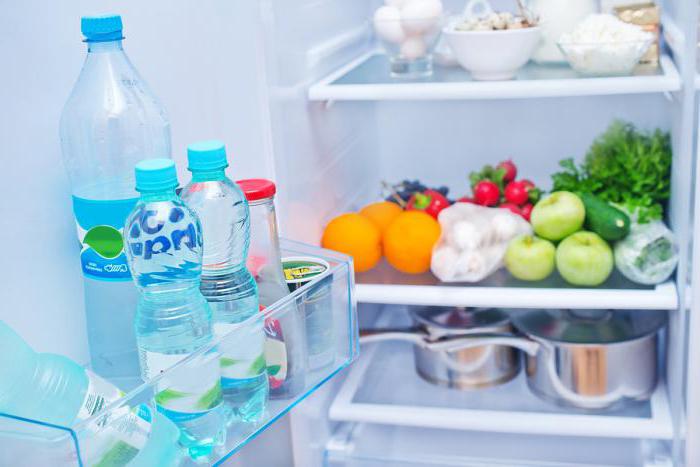
According to statistics, households require 29% of the country's electricity. This figure is higher only in the industrial sector - 31%. The refrigerator always works, so it is one of the largest consumers. German sociologists carried out work on the calculation of energy use by devices. It was found that if household appliances are regularly used at home - a washing machine, vacuum cleaner, iron, refrigerator, then this takes 30% of the resources. By this criterion, the technique is in 1st place. Even for other needs, less money is spent than on the operation of devices.
How many watts a refrigerator consumes per day is of interest not only to ordinary residents, but also to the country's authorities, since reducing such costs will save resources. European governments have passed a law requiring technology manufacturers to designate the energy consumption of each device.
Each customer, when choosing, can purchase the device that he considers economical. There are energy efficiency classes, which are usually denoted by Latin letters from A to G. The first 3 are the most profitable. The basis of this method is the establishment of the index, indicated in percent. Manufacturers divide the annual consumption of equipment into the industry average for such devices.
Manufacturers must indicate this information in the passport that is attached to the product. The calculations are presented there. Therefore, if it is interesting how many watts a refrigerator consumes per hour, you need to look in the documentation for the equipment.

Now selling equipment for the operation of which requires 230-460 kilowatts per year, if it is operated continuously. The approximate daily consumption can be found by dividing this indicator by 365 (the number of days in a year). As a result, it turns out that 64-120 watts are spent per day. But keep in mind that if used improperly, even a Class A refrigerator can spend up to 550 kilowatts per year. To reduce this indicator, several factors must be taken into account.
The annual indicator of the resources spent on the operation of the device depends on the power of freezing. This allows you to establish how many products are cooled per day, if the energy class is average. The higher it is, the higher the payment will be.
For example, to determine how many watts an Indesit refrigerator consumes, it is necessary to compare the power of freezing with the same indicator for other manufacturers of the same equipment. This unit has a freezing capacity of 30 kg / day. To determine whether it is a lot or a little, you need to familiarize yourself with the characteristics of other devices. For example, the LG refrigerator cools to -18 degrees 17 kg / day. This is less compared to Indesit. But it can be used for a large family where the speed of freezing is important. And as you know, comfort requires money.
To determine how many watts the Atlant refrigerator consumes, it is necessary to take into account the effect of temperature on the operation of the equipment. There are scientific laboratories that study the energy consumption of devices. Scientists performed experiments. As a result, it turned out to reveal some details.

If in the room where the refrigerator is located, +16 degrees, energy costs are reduced by 50%. But with an increase in air temperature to +30, the energy consumption of refrigeration equipment rises to 100%.
It should not be considered that an empty refrigerator spends little electricity. With low temperature, the stability of the device deteriorates, so it turns on often. This is especially true for the freezer. It must be filled completely, but not tightly. It should leave a place that will serve for air circulation. And the cold lost by the camera will be restored.
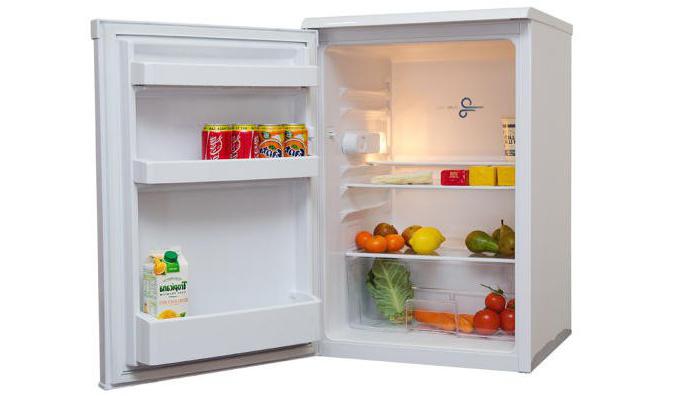
How many watts the refrigerator consumes at startup, how much it spends over the period the engine is functioning. With the opening of the door, warm air enters. Because of this, the resource consumption increases over several minutes. Therefore, it is not recommended to put warm food inside. An increase in humidity also increases consumption. How many watts does the Biryusa refrigerator consume? For a year this indicator is equal to 300-400 kW.
Electricity charges will be small if the following simple rules are followed:
Regular equipment maintenance is needed. This work is carried out by specialized organizations. The wizard checks for hardware problems. If something is found, you should give the equipment for repair, otherwise, if a breakdown occurs, restoration will be quite expensive.
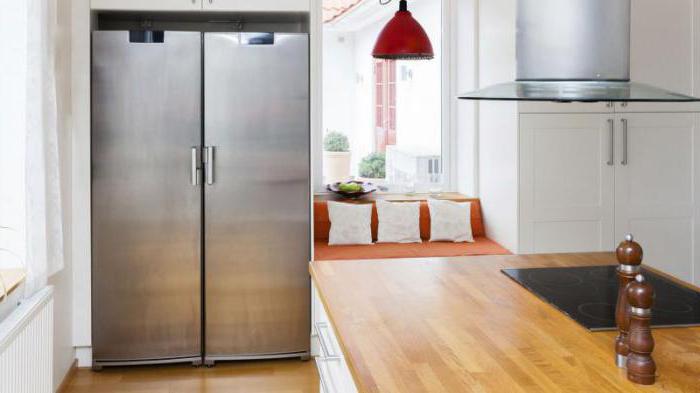
Thanks to these rules, it will be possible not only to save on electricity charges, but also to extend the life of the equipment. After all, a careful attitude to devices will help to avoid many problems.
When buying new equipment, you must pay attention to the above recommendations. Cheap appliances usually require extra maintenance. In such a technique, the seal on the doors is worn out in a short time, and energy consumption will be considerable.
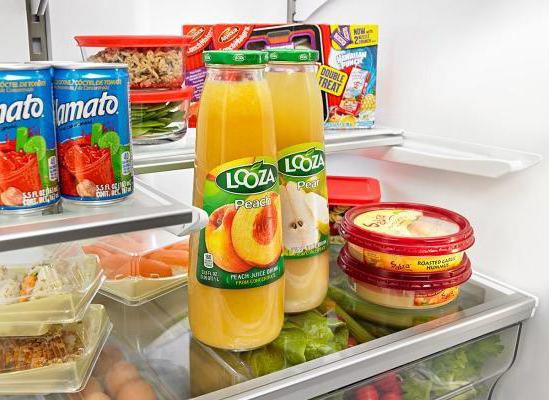
How much electricity will go to the operation of such equipment, not even professionals can say. Therefore, you do not need to save on quality. Choosing a refrigerator with the right consumption can save you money. At the same time, this will not hurt comfortable use.